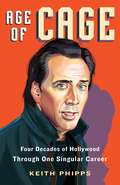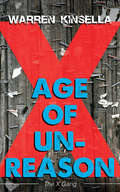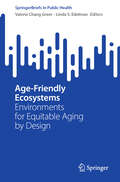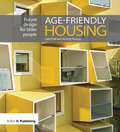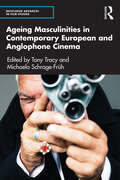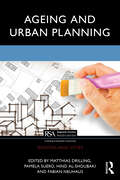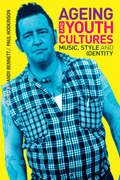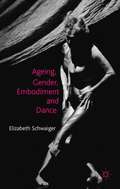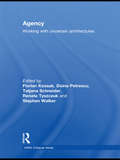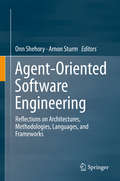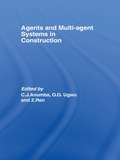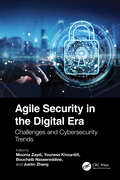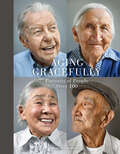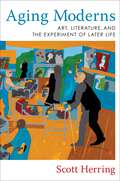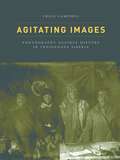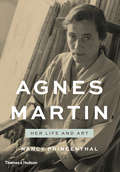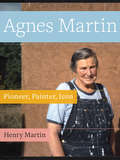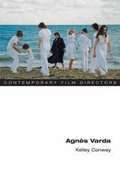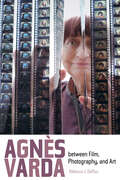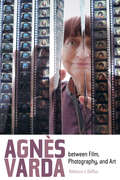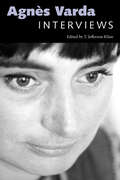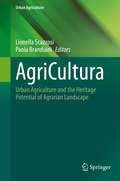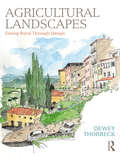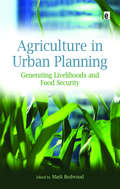- Table View
- List View
Age of Cage: Four Decades of Hollywood Through One Singular Career
by Keith Phipps“Age of Cage might be the closest we will get to understanding the singular beauty of each of Nic Cage’s always electric performances. You are holding the Rosetta Stone for Cage. Enjoy it.”—Paul Scheer, actor, writer and host of the How Did This Get Made? and Unspooled podcastsIcon. Celebrity. Artist. Madman. Genius. Nicolas Cage is many things, but love him, or laugh at him, there's no denying two things: you’ve seen one of his many films, and you certainly know his name. But who is he, really, and why has his career endured for over forty years, with more than a hundred films, and birthed a million memes?Age of Cage is a smart, beguiling book about the films of Nicolas Cage and the actor himself, as well as a sharp-eyed examination of the changes that have taken place in Hollywood over the course of his career. Critic and journalist Keith Phipps draws a portrait of the enigmatic icon by looking at—what else?—Cage’s expansive filmography.As Phipps delights in charting Cage’s films, Age of Cage also chronicles the transformation of film, as Cage’s journey takes him through the world of 1980s comedies (Valley Girl, Peggy Sue Got Married, Moonstruck), to the indie films and blockbuster juggernauts of the 1990s (Wild at Heart, Leaving Las Vegas, Face/Off, Con Air), through the wild and unpredictable video-on-demand world of today. Sweeping in scope and intimate in its profile of a fiercely passionate artist, Age of Cage is, like the man himself, surprising, insightful, funny, and one of a kind. So, snap out of it, and enjoy this appreciation of Nicolas Cage, national treasure.
Age of Unreason: The X Gang (The X Gang #3)
by Warren KinsellaThe X Gang must stand up for their beliefs in a changing world. A new face of violence and hate has come to Portland, Maine, and the punks in the X Gang find themselves targeted once again. It is the early eighties, and the youth subculture they have grown up in is changing. Kurt, X, and the others have reluctantly concluded that they are unlikely to ever change the world with their punk anthems, but that injustice is still worth fighting against. The friends lean on each other for the strength to deal with death, addiction, sexism, and racism they see all around them. Meanwhile, the police and the FBI are on the trail of a killer, and a member of the X Gang holds the secret to the fugitive’s sinister motivations. Age of Unreason tells the shocking story of how hatred can become a cause, and how we must stand together against it no matter the cost.
Age-Friendly Ecosystems: Environments for Equitable Aging by Design (SpringerBriefs in Public Health)
by Valerie Chang Greer Linda S. EdelmanThis compact book examines age friendliness within the framework of age-friendly ecosystems, and from a place-based approach, considering anchor institutions of neighborhoods, campuses and health environments as sites uniquely positioned to catalyze age equity and inclusivity. Age friendliness has grown from an idea into a social movement that recognizes the diversity of older adults, and integrates research, policy, programming and design practices. Compounding pressures of rapid aging, systemic ageism, and a growing disparity of resources compel us to rethink how we achieve equity in aging through the design of places and practices. Content for this book draws from a 2022 symposium, Age Friendly Communities as Platforms for Equity, Health & Wellness. Contributors build upon the content shared through the symposium in order to examine how neighborhoods, campuses and health environments are uniquely poised to support equity and to extend reach to historically marginalized populations of older adults. Ideas and experiences from national experts in aging, as well as "real world" experiences and narratives shared by older adults, students, community stakeholders and faculty researchers, are presented through a place-based approach. Collectively the voices in this book create a lens for empowering age-friendly ecosystems as environments for equitable aging by design. Among the topics covered: Creating an Age-Friendly Environment Across the Ecosystem Age Friendliness as a Framework for Equity in Aging Age-Friendly Voices in the Pursuit of an Age-Friendly Ecosystem Age-Friendly Futures: Equity by Design Age-Friendly Ecosystems: Environments for Equitable Aging by Design is written for people who are interested in understanding how the age-friendly movement is transforming places we live – community planners, designers, policy makers, aging service providers, academics and citizen activists. This compact volume presents a case of need for age friendliness in places we live, learn and care for our health. Readers with interests in the professional practice areas of aging studies/gerontology, architecture and planning, colleges and universities, community/neighborhood development, health systems, research, and policy will benefit from this brief that examines neighborhoods, campuses, and health environments from interdisciplinary perspectives.
Age-friendly Housing
by Julia Park Jeremy PorteousThis book embeds the principles of how we should approach the design of future housing for an ageing population, reminding us that this is not about ‘other people’, but about each of us. This book focuses on anticipating the needs and aspirations of the next generation of older people, and touches on what this implies for our communities, our towns and our cities, as well as for our living spaces. It will look at how well-designed buildings can facilitate the provision of care, support independence and wellbeing while providing companionship and stimulation. It will also examine how to ensure that buildings remain flexible over a long life. Dealing mainly with new-build, but with a section on adaptation and refurbishment, this book sets out the underlying design principles that should be applied and the early decisions that must be taken.
Ageing Masculinities in Contemporary European and Anglophone Cinema (Routledge Advances in Film Studies)
by Tony Tracy Michaela Schrage-FrühThis volume offers a unique exploration of how ageing masculinities are constructed and represented in contemporary international cinema. With chapters spanning a range of national cinemas, the primarily European focus of the book is juxtaposed with analysis of the social and cultural constructions of manhood and the "anti-ageing" impulses of male stardom in contemporary Hollywood. These themes are inflected in different ways throughout the volume, from considering how old age is not the monolithic and unified life stage with which it is often framed, to exploring issues of queerness, sexuality, and asexuality, as well as themes such as national cinema and dementia. Offering a diverse and multifaceted portrait of ageing and masculinity in contemporary cinema, this book will be of interest to scholars and students of film and screen studies, gender and masculinity studies, and cultural gerontology.
Ageing and Urban Planning (Regions and Cities)
by Fabian Neuhaus Matthias Drilling Hind Al-Shoubaki Pamela SueroAgeing and Urban Planning provides a critical analysis of urban planning in the face of demographic change. It emphasises the importance of international approaches and practices to address age-friendly planning. This process requires collaboration between professionals and the community, going beyond mere functionality to connect the micro and macro scales at the city, region, nation, and the global level.With an interdisciplinary and intersectional approach, the book draws on analytical lenses from architecture, gerontology, geography, sociology, and social and urban planning. It offers a thorough critique of popular narratives surrounding ageing and urban planning while presenting diverse case studies on a variety of spatial scales. The volume also covers the history of urban design for ageing and inclusivity in planning governance, as well as a critical look at the concept of "ageing in place" from the perspective of urban planning. The book offers a comprehensive selection of in-depth photos and figures from urban design studios, planning processes, and real-life scenarios. This collection provides a unique network of inspiring ideas. The book ultimately seeks to supplement the debate and promote a broader reflection about the transformations required in urban planning, given the opportunities and challenges related to a world with increased longevity.This valuable resource is recommended for advanced students, researchers, and policymakers in the fields of urban planning, age-related disciplines and professions, and social policy.
Ageing and Youth Cultures: Music, Style and Identity
by Paul Hodkinson Andy BennettWhat happens to punks, clubbers, goths, riot grrls, soulies, break-dancers and queer scene participants as they become older? For decades, research on spectacular 'youth cultures' has understood such groups as adolescent phenomena and assumed that involvement ceases with the onset of adulthood. In an age of increasingly complex life trajectories, Ageing and Youth Cultures is the first anthology to challenge such thinking by examining the lives of those who continue to participate into adulthood and middle-age. Showcasing a range of original research case studies from across the globe, the chapters explore how participants reconcile their continuing involvement with ageing bodies, older identities and adult responsibilities. Breaking new ground and establishing a new field of study, the book will be essential reading for students and scholars researching or studying questions of youth, fashion, popular music and identity across a wide range of disciplines.
Ageing, Gender, Embodiment and Dance
by Elisabeth SchwaigerThis book explores the nexus between gender, ageing and culture in dancers practicing a variety of genres. It challenges existing cultural norms which equate ageing with bodily decline and draws on an interdisciplinary theoretical framework to explore alternatives for developing a culturally valued mature subjectivity through the practice of dance.
Agency: Working With Uncertain Architectures
by Stephen Walker Doina Petrescu Tatjana Schneider Renata Tyszczuk Florian KossakWhile the potential of agency is most frequently taken to be the power and freedom to act for oneself, for the architectural community this also involves the power and responsibility to act as intermediaries on behalf of others. Presenting current thinking from practitioners and scholars from around the world, this book asks for a more active relationship between the humanities, the architectural profession, and society. Considering issues of architectural research as an agency of transformation, this book explores how humanities research can better contribute towards understanding current architectural needs.
Agent-Oriented Software Engineering: Reflections on Architectures, Methodologies, Languages, and Frameworks
by Onn Shehory Arnon SturmWith this book, Onn Shehory and Arnon Sturm, together with further contributors, introduce the reader to various facets of agent-oriented software engineering (AOSE). They provide a selected collection of state-of-the-art findings, which combines research from information systems, artificial intelligence, distributed systems and software engineering and covers essential development aspects of agent-based systems. The book chapters are organized into five parts. The first part introduces the AOSE domain in general, including introduction to agents and the peculiarities of software engineering for developing MAS. The second part describes general aspects of AOSE, like architectural models, design patterns and communication. Next, part three discusses AOSE methodologies and associated research directions and elaborates on Prometheus, O-MaSE and INGENIAS. Part four then addresses agent-oriented programming languages. Finally, the fifth part presents studies related to the implementation of agents and multi-agent systems. The book not only provides a comprehensive review of design approaches for specifying agent-based systems, but also covers implementation aspects such as communication, standards and tools and environments for developing agent-based systems. It is thus of interest to researchers, practitioners and students who are interested in exploring the agent paradigm for developing software systems.
Agents and Multi-Agent Systems in Construction
by C. J. Anumba O. O. Ugwu Z. RenThis book describes current advances and future directions in the theory and application of intelligent agents and multi-agent systems in the Architecture, Engineering and Construction (AEC) sector. It is the product of an international effort involving a network of construction IT and computing researchers, investigating different aspects of agent theory and applications. The contributed chapters cover different perspectives and application areas, and represent significant efforts to harness emerging technologies such as intelligent agents and multi-agent systems for improved business processes in the AEC sector. The first four chapters cover the theoretical foundations of agent technology whilst the remaining chapters deal with the application of agent-based systems in solving problems in the construction domain.
Agile Security in the Digital Era: Challenges and Cybersecurity Trends
by Justin Zhang Mounia Zaydi Youness Khourdifi Bouchaib NassereddineIn an era defined by rapid digital transformation, Agile Security in the Digital Era: Challenges and Cybersecurity Trends emerges as a pivotal resource for navigating the complex and ever-evolving cybersecurity landscape. This book offers a comprehensive exploration of how agile methodologies can be integrated into cybersecurity practices to address both current challenges and anticipate future threats. Through a blend of theoretical insights and practical applications, it equips professionals with the tools necessary to develop proactive security strategies that are robust, flexible, and effective. The key features of the book below highlight these innovative approaches.· Integration of agile practices: Detailed guidance on incorporating agile methodologies into cybersecurity frameworks to enhance adaptability and responsiveness.· Comprehensive case studies: Real-world applications and case studies that demonstrate the successful implementation of agile security strategies across various industries.· Future-proof security tactics: Insights into emerging technologies such as blockchain and IoT, offering a forward-looking perspective on how to harness these innovations securely.Intended for cybersecurity professionals, IT managers, and policymakers, Agile Security in the Digital Era serves as an essential guide to understanding and implementing advanced security measures in a digital world. The book provides actionable intelligence and strategies, enabling readers to stay ahead of the curve in a landscape where agile responsiveness is just as crucial as defensive capability. With its focus on cutting-edge research and practical solutions, this book is a valuable asset for anyone committed to securing digital assets against the increasing sophistication of cyber threats.
Aging Gracefully: Portraits of People Over 100
by Karsten ThormaehlenFall in love with 52 wise, healthy, and joyful 100-year-olds in this celebratory and uplifting art book. A beautiful and fascinating exploration of what it is like to be over 100 years old, Aging Gracefully invites readers to look into the face of a century of life experience with portraits of centenarians captured by the compassionate, minimalist lens of photographer Karsten Thormaehlen. The striking photographs are accompanied by short bios of the centenarians, featuring quotes and wisdom on love, food, humor, and living with grace.
Aging Moderns: Art, Literature, and the Experiment of Later Life
by Scott HerringWhat happens when the avant-garde grows old? Examining a group of writers and artists who continued the modernist experiment into later life, Scott Herring reveals how their radical artistic principles set out a new path for creative aging.Aging Moderns provides portraits of writers and artists who sought out or employed unconventional methods and collaborations up until the early twenty-first century. Herring finds Djuna Barnes performing the principles of high modernism not only in poetry but also in pharmacy orders and grocery lists. In mystery novels featuring Gertrude Stein and Alice B. Toklas along with modernist souvenir collections, the gay writer Samuel Steward elaborated a queer theory of aging and challenged gay male ageism. The Harlem Renaissance dancer Mabel Hampton dispelled stereotypes about aging through her queer of color performances at the Lesbian Herstory Archives. Herring explores Ivan Albright’s magic realist portraits of elders, Tillie Olsen’s writings on the aging female worker, and the surrealistic works made by Charles Henri Ford and his caregiver Indra Bahadur Tamang at the Dakota apartment building in New York City.Showcasing previously unpublished experimental art and writing, this deeply interdisciplinary book unites new modernist studies, American studies, disability studies, and critical age studies. Aging Moderns rethinks assumptions about literary creativity, the depiction of old age, and the boundaries of modernism.
Agitating Images: Photography against History in Indigenous Siberia (First Peoples: New Directions in Indigenous Studies)
by Craig CampbellFollowing the socialist revolution, a colossal shift in everyday realities began in the 1920s and &’30s in the former Russian empire. Faced with the Siberian North, a vast territory considered culturally and technologically backward by the revolutionary government, the Soviets confidently undertook the project of reshaping the ordinary lives of the indigenous peoples in order to fold them into the Soviet state. In Agitating Images, Craig Campbell draws a rich and unsettling cultural portrait of the encounter between indigenous Siberians and Russian communists and reveals how photographs from this period complicate our understanding of this history. Agitating Images provides a glimpse into the first moments of cultural engineering in remote areas of Soviet Siberia. The territories were perceived by outsiders to be on the margins of civilization, replete with shamanic rituals and inhabited by exiles, criminals, and &“primitive&” indigenous peoples. The Soviets hoped to permanently transform the mythologized landscape by establishing socialist utopian developments designed to incorporate minority cultures into the communist state. This book delves deep into photographic archives from these Soviet programs, but rather than using the photographs to complement an official history, Campbell presents them as anti-illustrations, or intrusions, that confound simple narratives of Soviet bureaucracy and power. Meant to agitate, these images offer critiques that cannot be explained in text alone and, in turn, put into question the nature of photographs as historical artifacts. An innovative approach to challenging historical interpretation, Agitating Images demonstrates how photographs go against accepted premises of Soviet Siberia. All photographs, Campbell argues, communicate in unique ways that present new and even contrary possibilities to the text they illustrate. Ultimately, Agitating Images dissects our very understanding of the production of historical knowledge.
Agnes Martin: Her Life and Art
by Nancy PrincenthalThe first biography of visionary artist Agnes Martin, one of the most original and influential painters of the postwar period Over the course of a career that spanned fifty years, Agnes Martin's austere, serene work anticipated and helped to define Minimalism, even as she battled psychological crises and carved out a solitary existence in the American Southwest. Martin identified with the Abstract Expressionists but her commitment to linear geometry caused her to be associated in turn with Minimalist, feminist, and even outsider artists. She moved through some of the liveliest art communities of her time while maintaining a legendary reserve. "I paint with my back to the world," she says both at the beginning and at the conclusion of a documentary filmed when she was in her late eighties. When she died at ninety-two, in Taos, New Mexico, it is said she had not read a newspaper in half a century. No substantial critical monograph exists on this acclaimed artist--the recipient of two career retrospectives as well as the National Medal of the Arts--who was championed by critics as diverse in their approaches as Lucy Lippard, Lawrence Alloway, and Rosalind Krauss. Furthermore, no attempt has been made to describe her extraordinary life. The whole engrossing story, told here for the first time, Agnes Martin is essential reading for anyone interested in abstract art or the history of women artists in America.
Agnes Martin: Night Sea (Afterall Books: One Work)
by Suzanne P. HudsonA close examination of Agnes Martin's grid painting in luminous blue and gold.Agnes Martin's Night Sea (1963) is a large canvas of hand-drawn rectangular grids painted in luminous blue and gold. In this illustrated study, Suzanne Hudson presents the painting as the work of an artist who was also a thinker, poet, and writer for whom self-presentation was a necessary part of making her works public. With Night Sea, Hudson argues, Martin (1912–2004) created a shimmering realization of control and loss that stands alone within her suite of classic grid paintings as an exemplary and exceptional achievement.Hudson offers a close examination of Night Sea and its position within Martin's long and prolific career, during which the artist destroyed many works as she sought forms of perfection within self-imposed restrictions of color and line. For Hudson, Night Sea stands as the last of Martin's process-based works before she turned from oil to acrylic and sought to express emotions of lightness and purity unburdened by evidence of human struggle.Drawing from a range of archival records, Hudson attempts to draw together the facts surrounding the work, which were at times obfuscated by the artist's desire for privacy. Critical responses of the time give a sense of the impact of the work and that which followed it. Texts by peers including Lenore Tawney, Donald Judd, and Lucy Lippard are presented alongside interviews with a number of Martin's friends and keepers of estates, such as the publisher Ronald Feldman and Kathleen Mangan of the Lenore Tawney archive, which holds correspondence between Martin and Tawney.
Agnes Martin: Pioneer, Painter, Icon
by Henry MartinThis is an intimate and revealing biography of Agnes Martin, renowned American painter, considered one of the great women artists of the 20th and 21st Century. A resident of both New Mexico and New York City, Martin has always remained an enigma due to her fiercely guarded private life. Henry Martin, award-winning writer, and art scholar, having access to those who were close to Agnes Martin—friends, family, former lovers—gives us a full portrait of this universally revered artist. Readers will learn of her bouts with mental illness, her several significant lesbian relationships, and her lifelong yearning for recognition despite her reclusive lifestyle and need for privacy. Arriving in the wake of major international retrospective exhibitions of her work from London's Tate Modern, LACMA in Los Angeles, and the Guggenheim in New York City, this book provides a perspective of Agnes Martin that has not been seen in earlier, more academic works or fine-art monographs. Certain to be a mainstay for readers of the arts, and admirers of the creative spirit, this book also includes rare photographs from Martin's family and friends, many of which have never appeared in a book before.
Agnes Varda (Contemporary Film Directors)
by Kelley ConwayBoth a precursor to and a critical member of the French New Wave, Agnès Varda weaves documentary and fiction into tapestries that portray distinctive places and complex human beings. Critics and aficionados have celebrated Varda's independence and originality since the New Wave touchstone Cleo from 5 to 7 (1962) brought her a level of international acclaim she has yet to relinquish. Film historian Kelley Conway traces Varda's works from her 1954 debut La Pointe Courte through a varied career that includes nonfiction and fiction shorts and features, installation art, and the triumphant 2008 documentary The Beaches of Agnès . Drawing on Varda's archives and conversations with the filmmaker, Conway focuses on the concrete details of how Varda makes films: a project's emergence, its development and the shifting forms of its screenplay, the search for financing, and the execution from casting through editing and exhibition. In the process, she departs from film history's traditional view of the French New Wave and reveals one artist's nontraditional trajectory through independent filmmaking. The result is an intimate consideration that reveals the artistic consistencies and bold changes in the career of one of the world's most exuberant and intriguing directors.
Agnes Varda between Film, Photography, and Art
by Rebecca J. DeRooAgnès Varda is a prolific film director, photographer, and artist whose cinematic career spans more than six decades. Today she is best known as the innovative "mother" of the French New Wave film movement of the 1950s and '60s and for her multimedia art exhibitions. Varying her use of different media, she is a figure who defies easy categorization. In this extensively researched book, Rebecca J. DeRoo demonstrates how Varda draws upon the histories of art, photography, and film to complicate the overt narratives in her works and to advance contemporary cultural politics. Based on interviews with Varda and unparalleled access to Varda's archives, this interdisciplinary study constructs new frameworks for understanding one of the most versatile talents in twentieth and twenty-first century culture.
Agnes Varda between Film, Photography, and Art
by Rebecca J. DerooAgnès Varda is a prolific film director, photographer, and artist whose cinematic career spans more than six decades. Today she is best known as the innovative “mother” of the French New Wave film movement of the 1950s and '60s and for her multimedia art exhibitions. Varying her use of different media, she is a figure who defies easy categorization. In this extensively researched book, Rebecca J. DeRoo demonstrates how Varda draws upon the histories of art, photography, and film to complicate the overt narratives in her works and to advance contemporary cultural politics. Based on interviews with Varda and unparalleled access to Varda's archives, this interdisciplinary study constructs new frameworks for understanding one of the most versatile talents in twentieth and twenty-first century culture.
Agnes Varda: Interviews (Conversations with Filmmakers Series)
by T. Jefferson KlineOver nearly sixty years, Agnès Varda (b. 1928) has given interviews that are revealing not only of her work, but of her remarkably ambiguous status. She has been called the “Mother of the New Wave” but suffered for many years for never having been completely accepted by the cinematic establishment in France. Varda's first film, La Pointe Courte (1954), displayed many of the characteristics of the two later films that launched the New Wave, Truffaut's 400 Blows and Godard's Breathless. In a low-budget film, using (as yet) unknown actors and working entirely outside the prevailing studio system, Varda completely abandoned the “tradition of quality” that Truffaut was at that very time condemning in the pages of Cahiers du cinema. Her work, however, was not “discovered” until after Truffaut and Godard had broken onto the scene in 1959. Varda's next film, Cleo from 5 to 7, attracted considerably more attention and was selected as France's official entry for the Festival in Cannes. Ultimately, however, this film and her work for the next fifty years continued to be overshadowed by her more famous male friends, many of whom she mentored and advised. Her films have finally earned recognition as deeply probing and fundamental to the growing awareness in France of women's issues and the role of women in the cinema. “I'm not philosophical,” she says, “not metaphysical. Feelings are the ground on which people can be led to think about things. I try to show everything that happens in such a way and ask questions so as to leave the viewers free to make their own judgments.” The panoply of interviews here emphasizes her core belief that “we never stop learning” and reveal the wealth of ways to answer her questions.
AgriCultura: Urban Agriculture and the Heritage Potential of Agrarian Landscape (Urban Agriculture)
by Lionella Scazzosi Paola BranduiniThis book explains how cultural heritage can be a tool for enhancing urban agriculture and improving landscape and life quality. It cuts across the existing literature and fills the gaps between urban agriculture, considered as a food, social and environmental opportunity and cultural heritage, considered as resource. It focuses the role of the countryside for urban areas, in the history of the city and today. Its attention is on the quality for all areas, both outstanding, ordinary and degraded, as well as large, little or fragmented (European landscape convention 2000). It considers agricultural landscape as a system of tangible and intangible heritage components and relationships, to be retained, enhanced and transmit, in a process of inevitable but appropriate dynamic conservation and management over time (ICOMOS-IFLA Principles 2017). This book can benefit the collaboration among local players – such as farmers, citizens, associations, public institutions, stakeholders – in conserving and enhancing agrarian heritage and reinforcing the identity of places and people. It can strengthen collective action and generate positive effects on good large and local -scale management. The first part has a methodological character in order to enlighten the integrated approach between cultural heritage and urban agriculture. The second part exemplifies cases where the heritage has been recognised but not yet translated into concrete action. The third Part discloses ongoing process of co-construction, where policies have recognized the cultural, environmental and social meaning of urban agriculture as heritage. This book aims to reach scholars, local administrations, professionals, farmers and citizens. It involves many authors, many of whom are directly engaged with action-research in safeguarding and implementing the mutual interaction between urban agriculture activities and agrarian heritage.
Agricultural Landscapes: Seeing Rural Through Design
by Dewey ThorbeckAgricultural Landscapes: Seeing Rural Through Design follows on from the author’s previous books, Rural Design and Architecture and Agriculture, to encourage using design thinking to provide greater meaning and understanding of places where humans live and work with the rural landscape. Rural areas around the world are often viewed as special places with cultural, historical and natural significance for people. Dewey Thorbeck emphasizes the importance of these rural sites and their connections to urban areas through full-color case studies of these places with particular emphasis on Globally Important Agricultural Heritage Systems (GIAHS), as identified by the UN Food and Agriculture Organization, to document and explore personal experiences, lessons learned, and implications for the future. Rural landscapes are part of everyone’s heritage, and the book shows these connections and the unique GIAHS land use systems and landscapes as models for a more sustainable and prosperous rural and urban future. It includes practical examples of working places where growing food, raising animals, or harvesting from the sea has been the primary economy for centuries to exhibit a clear and sustainable local relationship between humans, animals, buildings, climate and place. Aimed at students, teachers and professionals, this book investigates how design thinking can be used to integrate rural and urban sites to shape land use for more sustainable futures.
Agriculture in Urban Planning: Generating Livelihoods and Food Security
by Mark RedwoodThis volume, by graduate researchers working in urban agriculture, examines concrete strategies to integrate city farming into the urban landscape. Drawing on original field work in cities across the rapidly urbanizing global south, the book examines the contribution of urban agriculture and city farming to livelihoods and food security. Case studies cover food production diversification for robust and secure food provision; the socio-economic and agronomic aspects of urban composting; urban agriculture as a viable livelihood strategy; strategies for integrating city farming into urban landscapes; and the complex social-ecological networks of urban agriculture. Other case studies look at public health aspects including the impact of pesticides, micro-biological risks, pollution and water contamination on food production and people. Ultimately the book calls on city farmers, politicians, environmentalists and regulatory bodies to work together to improve the long term sustainability of urban farming as a major, secure source of food and employment for urban populations. Published with IDRC
